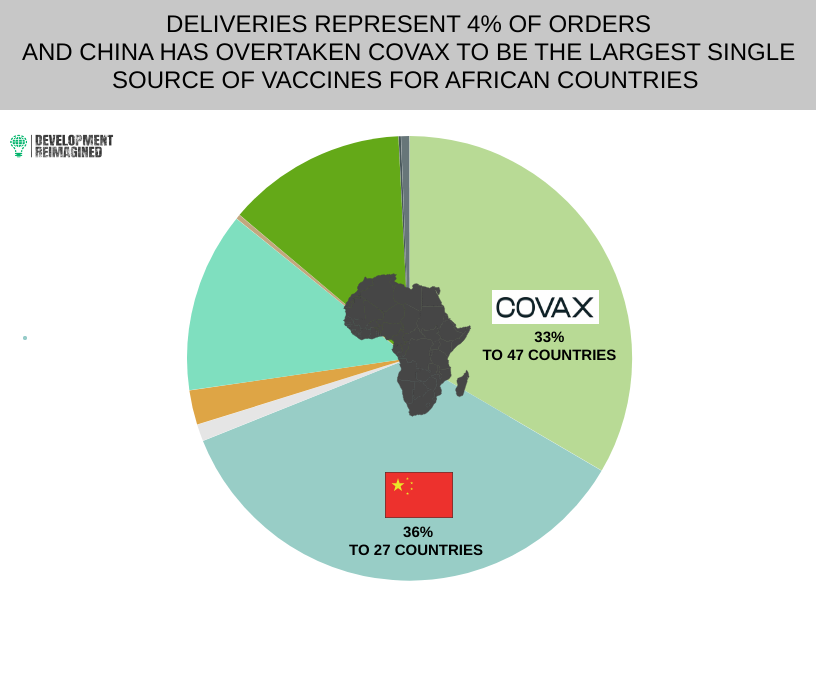Updated Every Month
Nearly 1.33 billion vaccine doses have been ordered by African countries and the African Union – that’s enough to fully vaccinate half of the population, getting close to herd immunity levels, but as of early June, African countries have received only 1.5% of the world’s vaccines. While media has focused this month on what the G7 can do for the world, Mauritius has donated 250,000 vaccines to COVAX, and the data suggests that China has become (for the first time this month) the largest source of vaccines for African countries overall. How?
Let’s explain.
While Burundi, Eritrea, Sahrawi Republic, and Tanzania have yet to place orders, all other 51 nations have done so. The vast majority have ordered through the COVAX initiative – it accounts for 43% of all orders made, while China, AstraZeneca, MTU/AU initiatives each make up roughly 17% of doses ordered so far.
But of the 51 countries, 50 African nations have received a total of 50 million doses – accounting for just 4% of orders. Of this, 12 million have arrived in the last month (this is double the pace of deliveries last month).
That means deliveries can potentially cover – at most – a disappointing 1.9% of Africa’s entire population.
The data suggests that COVAX has underdelivered versus expectations and needs. Only 7% of COVAX orders – the majority for free – have been delivered.
In contrast, the over 1 million doses India pledged to donate have all been delivered as of this month. Almost 90% of the over 6 million doses African countries ordered from China – both paid for and for free – have arrived. These deliveries matter. In terms of doses received, for the first time this month China has now become the leading vaccine provider in Africa; narrowly surpassing COVAX.
Ideally, then, African countries should order more from these other providers. They have demonstrated a capacity to deliver.
As for administering the vaccines…
In total, 31.8 million doses have been administered throughout the continent, with 25 countries having vaccinated over 1% of their population, and still only three African countries having fully vaccinated over 10% of their populations. Seychelles, Morocco and Mauritius. That means on average, still, less than 1 in 100 people have been fully vaccinated in Africa. In comparison, this figure is 42 in 100 in USA, and 21 in 100 across the European Union. China is aiming for 40 in 100 by the end of June.
Or, put another way, the number of vaccines administered globally DAILY is just above the entire amount of vaccines that have been administered in Africa to date.
Yet, the difference in African countries is not because of dysfunctional health systems, it’s because of availability. Almost half – 23 – of the 50 countries that have received vaccines have already used up over 50% of them.
That said, COVID19 has been less prevalent in Africa in many other regions. Is a low vaccination rate tenable under those circumstances? Yes – to some degree IF testing, border controls and social distancing can continue. However, while testing continues to rise steadily on the continent, it remains at just 2% of global rates. Border controls and social distancing are also placing stress on African people, especially when it comes to economic recovery – especially tourism.
Low vaccination rates are also risky. Two countries – Angola and Namibia – both with vaccination rates under 1% – are currently facing higher cases or deaths than ever recorded, and both have detected new strains of COVID19. While there does not appear to be a full outbreak in either of these countries (cases detected are under 2000, deaths under 60 per day), it is possible that further mutation could take place and affect other African countries and beyond as well.
What does this mean for June? Four things:
- COVAX should step up and deliver more, faster, especially now that Chinese vaccines have been approved by the WHO;
- African governments should diversify suppliers beyond COVAX as soon as possible;
- African governments and others should continue to push for deals, IP waivers and changes to procurement rules to be able to manufacture locally, especially as it becomes clear that vaccine boosters will be needed – such dependency on the global supply chain is very risky;
- Africans should continue to social distance and ramp up testing. The costs of not doing so remain too high, despite vaccines.
To review the data yourself, check out the graphics and numbers below, and do let us know what you find surprising, worrying, or reassuring, and what you’d like us to find out next month.

To find out how Development Reimagined can support you, your organisation or Government during the COVID-19 outbreak please email the team at clients@developmentreimagined.com .
Special thanks go to Rosie Wigmore, Saeger Godson and Jing Cai for their work on the graphic and collecting/analysing the underlying data and this accompanying article.
The data was collated primarily from Africa CDC, as well as other sources including: government websites and media reports, the IMF policy tracker; Worldometer and the New York Times Vaccine Tracker. Our methodology is entirely in-house, based on analysis of vaccine, testing, spending, social distancing, income categories and other trends. Note that vaccine data for Mauritius is unclear on the Africa CDC website.
If you spot any gaps or have any enquiries, please send your feedback to us at team@developmentreimagined.com, we will aim to respond asap.
June 2021


